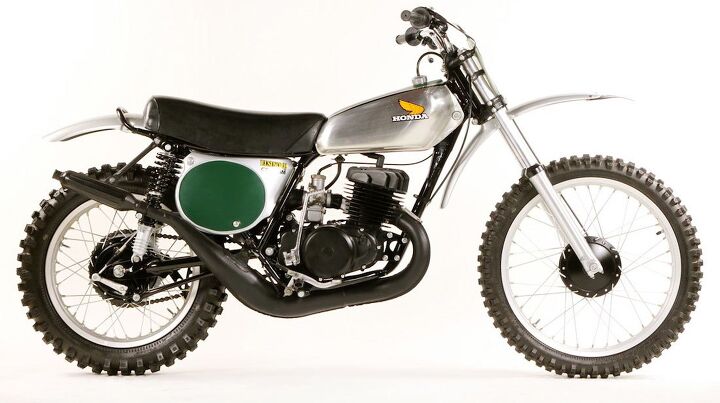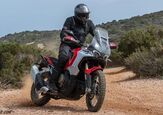Miguel Galluzzi's Top 10 Favorite Motorcycles
The man who built the Monster on the world's most significant motorcycles
This week’s Top 10 comes to us courtesy of Miguel Galluzzi. Mr. G is best known for designing Ducati’s original Monster and starting the modern naked-bike movement, but before that he also penned Ducati’s early ’90s 900 Supersports. He’s been a busy man ever since, and is currently director for PADC (Piaggio Advanced Design Center), in Pasadena, CA, where he – together with another design team in Noale, Italy – cooks up new Moto Guzzis, Aprilias and other Italian delicacies. —John Burns
I’ll tell you a story, maybe it will help us shorten the list. I grew up in a family that was involved in motorsports in Argentina since my grandfather raced Harleys and Hendersons in the 1920s and 30s. Because of that, my father and uncles were involved in many kinds of racing, from bicycles in the ’40s, motorcycles in the ’50s and ’60s to cars in the ’70s and ’80s. My upbringing was around machines with engines, two wheels or four, it didn’t matter.
10. Norton Manx
In 1959, the day I was born, my father had to win the race that weekend to be able to pay the hospital bill… The bike he won the race with was a Norton Manx (short stroke). The lines, the gas tank, the stance, the colors, the sound, the smells, still today, are just… no words to express it. So it has to be on my list!
9. Honda CB750
I was 10, and one weekend I convinced my uncle and father to go to a motocross race happening in the outskirts of Buenos Aires. We rode two of my uncles’ bikes, one a 1948 Vincent Black Shadow and the other the first Honda CB750 Four that arrived in Argentina. The memories of the the MX race are vague, but the trip to and from the track still give the chills. I knew a bit about the Honda; who didn’t? It was the hottest thing in the world, and the idea of a four-cylinder in a bike, a disc brake, instrument cluster, what!? That was space travel talk for a very impressionable 10-year-old kid.
8. Vincent Black Shadow
But the Vincent was the winner that afternoon. It had the image of an “old” bike, but a closer look revealed something impossible… there was no frame, the shocks were in the wrong place, and that black engine??? Engines were supposed to be shiny pieces of beautiful aluminum. The Vincent was noisy, loud, a Twin – who wanted a Twin then? Riding on the back seat of both bikes, the sensations are forever in my mind, and I still consider that afternoon my real introduction to the world of motorcycling, so both bikes are going to the list.
7. Honda CR250M Elsinore
A couple of years after that afternoon, we started racing MX with my brother, Marco. Motocross was the up and coming motorcycle sport – to the disappointment of our family, there was no road racing for us. We wanted the dirt and long hair, just like Marty Smith in the USA and everybody else around the motorcycle world. By 1973, Honda revolutionized the whole scene with the CR250M Elsinore, making extremely high technology for the time affordable to everybody. The polished aluminum tank still blinks at me every time I see one! The European brands were better, but everybody could afford to buy and live with an MX bike from Japan. You could race every weekend without spending a fortune – just clean and oil the air filter, install a colder or warmer spark plug and new piston rings every, how many races?? Still debating that point…
6. Moto Guzzi LeMans 850
As we grew up, we started working in our father’s motorcycle dealership after school. Motorcycles were our daily bread, and big bikes, our dreams. We were selling Hondas and Yamahas, lots of them, affordable motorcycles, and everybody became a motorcyclist. During those years, European brands were having a hard time fighting the Japanese. The catching up was tough – some brands disappeared, others tried hard to reinvent themselves. One afternoon while at the dealer, I saw a friend of mine riding this motorcycle (no helmet laws at that time). It had a little fairing painted orange fluoro. We spent the afternoon riding this LeMans, and I remember thinking to myself, “This thing is rough, it’s Italian – but how much motorcycle it is!”
It just felt different. The bikes we were selling at that time were just perfect, but something was missing, something I discovered later on while working in Italy. The passion involved in the process of creating an Italian motorcycle is something unique and still today creates the difference in what we ride. Special place for the LeMans on the list!
5. BMW R100RS
To me, this bike means the first summer in the USA, riding around South Florida on the first production motorcycle with a fairing. The catching-up was forcing manufacturers to outsmart the Japanese with new ideas, and the R100RS with its fairing and almost solo seater configuration was killing it – and the blue anodized front brake calipers?? Superbike racing was in its infancy in the USA, and BMW understood it better than everyone else.
4. Harley-Davidson XLCR
While in Florida, stopped at a traffic light, I saw for the first time the XLCR – it was black, it was loud and not just the engine sound… the whole thing said: watch me! The Morris wheels with the white lettering on the tires – muscle car territory but mixed with cafe-racer language. Just superb! During the ’80s, while I was studying in the USA, I tried to buy one, but everybody I talked to said “stay away.” I regret listening to them many times over!
3. Suzuki Katana
Motorcycle design has been my job for many decades now, and I still remember the moment the Katana appeared in some magazine in the USA. It was a prototype from Suzuki in Germany, something that looked more impossible than real. Definitely unique, different proportions – a rider was seated inside the bike, more like a racing bike than a standard bike, almost clip-ons, the two-step seat, lots of details that still today scream. Way ahead of everybody else. Even the Japanese needed to move forward. The significance of the Katana is also that it represents the first time a Japanese manufacturer went to an outside supplier to have input in a production bike – or better said, that an outsider was able to put in production a proposal that seemed just a show prototype.
2. Honda RC30
By 1986, I was living in Germany working for Opel AG in the car world. My motorcycles were mostly in paper and at night, trying to compensate for the boredom of the auto industry. The projects’ timeframes were decades, and everything took years. My boss at that time had some friends in Honda Europe, so since Honda wanted to go to Italy to open a design studio there to understand how Italians do it, I was hired. I started working in Honda Germany’s office for a while and it was during that time that I first encountered the RC30. The level of fit and finish was above anything else I’d seen before. It was a production bike, but the technology was better than racing. I remember going to the garage where all the bikes were parked and just sitting on it, touching, peeking my finger into each little part. I couldn’t ride it due to some kind of insurance deal, but that first impression would be reinforced a couple of years later. While on my new job with Cagiva in Italy and visiting for the first time CRC, which was still in Rimini, they were working on a new Ducati and had an RC30 completely apart. The RC30 technology was unexplainable at the time, so they had to dissect it. On my list!!
1. Britten V1000
The year 1990 found me working for the Cagiva Group, cutting fairings to show how Ducatis needed to show their engines. During those days, I had a chance of a lifetime: I spent an afternoon in our model shop at Varese with John Britten, who was in Italy for the week because of some Monza races. That afternoon remains one of the peaks of my career. Britten explained in detail how he was able to construct each part. Being in New Zealand, so far away from everything, forced him to do everything himself. I still remember his explanation of the carbon wheels construction.
The V1000 is a bike where one could start from the front axle and spend hours enjoying each detail all the way to the tail. The simplicity of each makes the whole amazing, and the best part is that it goes, and fast. Carbon fiber, engine, radiator, layout, construction, exhaust – the list goes on, still today, one amazing motorcycle icon. One thing we shared with Mr. Britten for certain: our passion for the Vincent Black Shadow.
Well, it was really difficult to keep the list down to 10, and this closes it for now. The Monsters, RSV4s and Californias are for a new chapter. –Miguel
More by Miguel Galluzzi






































Comments
Join the conversation
Very good choices from a man who has inspired many a beautiful works of art,that not only look good standing still but can breath life to both the design and the rider. Thank you Señor Galluzzi for sharing your thoughts and fond memories. The Vincent is...to this day in my eyes the romantic epitome of all classic motorcycles.
A treat, from his background to his choices. The allure of motorcycles transcends nationality and time.